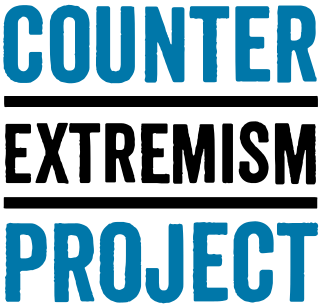Related Research Articles
Terrorism and mass attacks in Canada includes acts of terrorism, as well as mass shootings, vehicle-ramming attacks, mass stabbings, and other such acts committed in Canada that people may associate with terroristic tactics but have not been classified as terrorism by the Canadian legal system.
Radicalization is the process by which an individual or a group comes to adopt increasingly radical views in opposition to a political, social, or religious status quo. The ideas of society at large shape the outcomes of radicalization. Radicalization can result in both violent and nonviolent action – academic literature focuses on radicalization into violent extremism (RVE) or radicalisation leading to acts of terrorism. Multiple separate pathways can promote the process of radicalization, which can be independent but are usually mutually reinforcing.

The Institute for Strategic Dialogue (ISD) is a political advocacy organization founded in 2006 by Sasha Havlicek and George Weidenfeld and headquartered in London, United Kingdom.
The United Nations Interregional Crime and Justice Research Institute (UNICRI) is one of the five United Nations Research and Training Institutes. The institute was founded in 1968 to assist the international community in formulating and implementing improved policies in the field of crime prevention and criminal justice. Its work currently focuses on Goal 16 of the 2030 Agenda for Sustainable Development, that is centred on promoting peaceful, just and inclusive societies, free from crime and violence.
CONTEST is the United Kingdom's counter-terrorism strategy, first developed by Sir David Omand and the Home Office in early 2003 as the immediate response to 9/11, and a revised version was made public in 2006. Further revisions were published on 24 March 2009, 11 July 2011 and June 2018. An Annual Report on the implementation of CONTEST was released in March 2010 and in April 2014. The aim of the strategy is "to reduce the risk to the UK and its interests overseas from terrorism so that people can go about their lives freely and with confidence." The success of this strategy is not linked to total elimination of the terrorist threat, but to reducing the threat sufficiently to allow the citizens a normal life free from fear.
Dr. Edit Schlaffer, is a social scientist and the founder of Women Without Borders, based in Vienna, Austria. Her international efforts focus on grassroots, community-based female diplomacy, namely empowering women as agents of change and a critical driving force in stabilizing an insecure world.

The Global Center on Cooperative Security is an independent, nonpartisan, not-for-profit research and policy institute based in New York, Washington D.C., London, Brussels, and Nairobi. The Global Center works to improve multilateral security cooperation through policy research and issue-area projects throughout the world.
Islamic extremism in the United States comprises all forms of Islamic extremism occurring within the United States. Islamic extremism is an adherence to fundamentalist interpretations of Islam, potentially including the promotion of violence to achieve political goals. In the aftermath of the September 11, 2001 terror attacks, Islamic extremism became a prioritized national security concern of the U.S. government and a focus of many subsidiary security and law enforcement entities. Initially, the focus of concern was on foreign Islamic terrorist organizations, particularly al-Qaeda, but in the course of the years since the September 11 terror attacks, the focus has shifted more towards Islamic extremist radicalized individuals and jihadist networks within the United States.

The Bureau of Conflict and Stabilization Operations (CSO) is a bureau of the United States Department of State.

Against Violent Extremism (AVE) is a global network of former extremists, survivors of violence and interested individuals from the public and private sectors - working together to counter all forms of violent extremism. A partnership between London’s Institute for Strategic Dialogue, Google Ideas and the Gen Next Foundation. AVE's stated aim is to offer a platform for communication, collaboration and a means for activists to find resources and funding for projects.

Violent extremism is a form of extremism that condones and enacts violence with ideological or deliberate intent, such as religious or political violence. Violent extremist views often conflate with religious and political violence, and can manifest in connection with a range of issues, including politics, religion, and gender relations.
The International Centre for Counter-Terrorism (ICCT) is an independent think-and-do tank providing multidisciplinary policy advice and practical support focused on prevention, the rule of law and current and emerging threats three important parts of effective counter-terrorism work.

The Counter Extremism Project (CEP) is a non-profit non-governmental organization that combats extremist groups "by pressuring financial support networks, countering the narrative of extremists and their online recruitment, and advocating for strong laws, policies and regulations".

Domestic terrorism or homegrown terrorism is a form of terrorism in which victims "within a country are targeted by a perpetrator with the same citizenship" as the victims. There are various different definitions of terrorism, with no universal agreement about it.

The National Counter Terrorism Agency is an Indonesian non-ministerial government department that works to prevent terrorism. BNPT is headed by a chief, who is responsible to the President. When it was first launched, the leader of BNPT held the ranking of a civil servant but the Presidential Regulation in 2012 elevated the post of BNPT Chief to the ministerial level.
The U.S. National Action Plan on Women, Peace, and Security was adopted when President Barack Obama signed an executive order on December 19, 2011, 11 years after the United Nations Security Council adopted United Nations Security Council Resolution 1325 on women, peace, and security. It specified initiatives and activities that will empower and enlist women and girls in efforts to achieve international peace and security. The U.S. NAP was formally revised in June 2016. On June 11, 2019, the White House released the U.S. Strategy on Women, Peace, and Security, which superseded the National Action Plan.
Countering Violent Extremism (CVE) was a US government program established under the Obama administration to counter all violent ideologies held by groups or individuals in the US by engaging communities in the counterterrorism effort and by education programs or counter-messaging. The program worked with community groups such as local governments, police departments, universities, and non-profits. It recruited community leaders, teachers, social workers, and public health providers to help the government in identifying people "at risk" of becoming violent extremists.
Online youth radicalization is the action in which a young individual or a group of people come to adopt increasingly extreme political, social, or religious ideals and aspirations that reject, or undermine the status quo or undermine contemporary ideas and expressions of a state, which they may or may not reside in. Online youth radicalization can be both violent or non-violent.

Nonviolent extremism is the expression of extremist ideas through nonviolent means, without the use of terrorism or political violence. It can be contrasted with violent extremism. Nonviolent extremism manifests from the same ideologies as violent extremism, including right wing extremism, left wing extremism, and religious extremism. Much of the study of nonviolent extremism focuses on its potential to produce or incite violent extremism.
Local Youth Corner Cameroon (LOYOC) is a Cameroonian non-governmental organization founded in 2002 to react on the increase in the socio-political and economic challenges facing young people. LOYOC focuses on youth empowerment in the domain of peacebuilding, healthy living, preventing and countering violent extremism.
References
- 1 2 3 4 5 6 7 8 9 10 11 12 13 14 15 16 17 18 19 20 21 22 23 "Strategic Implementation Plan for Empowering Local Partners to Prevent Violent Extremism in the United States" (PDF). whitehouse.gov . December 2011. Retrieved 2012-01-04– via National Archives.
- 1 2 3 4 5 6 7 8 "Empowering Local Partners to Prevent Violent Extremism in the United States" (PDF). whitehouse.gov . August 2011. Retrieved 2012-01-04– via National Archives.
- 1 2 3 4 5 6 7 8 Temple-Raston, Dina (2011-08-03). "White House Unveils Counter-Extremism Plan". NPR. Retrieved 2012-04-08.
- 1 2 3 Bjelopera, Jerome (2011-11-15). "American Jihadist Terrorism: Combating a Complex Threat" (PDF). Congressional Research Service. Retrieved 2012-04-10.
- 1 2 "Obama Administration Outlines Extremism Strategy". American-Arab Anti-Discrimination Committee. 2011-08-04. Archived from the original on 2012-04-12. Retrieved 2012-04-07.
- ↑ "CAIR Backs President's Plan to Fight Violent Extremism". Council on American-Islamic Relations. 2011-08-04. Archived from the original on 2013-01-18. Retrieved 2012-04-08.
- 1 2 3 Temple-Raston, Dina (2011-12-08). "Officials Detail Plans to Fight Homegrown Terrorism". NPR. Retrieved 2012-04-08.
- ↑ "King Statement on Obama Administration Violent Extremism Strategy". House Committee on Homeland Security. 2011-08-03. Retrieved 2012-04-08.
- ↑ "Lieberman, Collins React to Administration Strategy to Countering Violent Extremism". Senate Committee on Homeland Security and Governmental Affairs. 2011-08-03. Retrieved 2012-04-08.
- 1 2 "Lieberman, Collins React to Administration's Countering Violent Extremism Strategic Implementation Plan". Senate Committee on Homeland Security and Governmental Affairs. 2011-12-08. Retrieved 2012-04-08.
- 1 2 3 Gaffney, Frank (2011-10-31). "The enemy is inside the wire". Center for Security Policy. Archived from the original on 2011-11-03. Retrieved 2012-04-07.